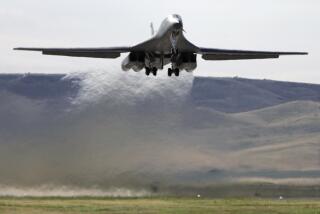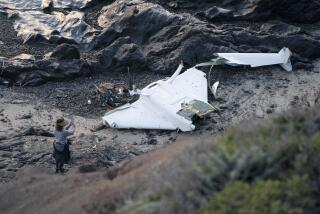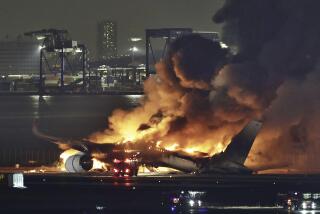Data From Crash-Landing Test Cited : FAA Seeks New Safety Rules for Jet Seats
WASHINGTON — Partly because of test data from the spectacular remote-controlled crash landing of a jetliner at Edwards Air Force Base last December, the Federal Aviation Administration will propose new safety standards to improve the strength of passenger seats on commercial airliners.
FAA Administrator Donald D. Engen said Tuesday that the standards, designed to improve passengers’ chances of surviving some crashes, will be proposed next June and will apply to new aircraft.
Existing airplanes will not be covered because retrofitting current aircraft could require extensive and costly changes in the planes’ floors and seat attachments.
Engen said FAA research on the desirability of seats that can withstand crashes better has been carried out over the last three years and was corroborated by data collected from the government’s test crash of a four-engine Boeing 720 jet Dec. 1.
$11.8-Million Effort
The test, an $11.8-million effort by the FAA and the National Aeronautics and Space Administration, ended in a massive and largely unanticipated fire that was fed by the plane’s fuel, even though it was operating with a special kerosene mixture designed to minimize such occurrences.
But Engen, appearing before the subcommittee on transportation, aviation and materials of the House Science and Technology Committee, called the test successful because it produced a wealth of data about cabin safety and structural protection.
Engen said that, despite the fire, “the fuselage remained essentially intact and provided a habitable space for the occupants.” Had human passengers, instead of dummies, been aboard the plane, some would have survived the impact and could have escaped before heavy smoke filled the cabin, he said.
Rep. William Carney (R-N.Y.), who watched the crash, disagreed. “There is no way I’d ever be convinced that it was survivable,” he said.
Passengers Protected
The test plane was equipped with a variety of seats of different designs. Films of the crash showed that almost all of the seats remained in place and protected the passengers, as did fire-blocking layers built into the seats.
Engen said that, until an analysis of crash data is completed this summer, the FAA will not proceed with any proposal on requiring airlines to use a special anti-misting fuel designed to prevent a lethal fireball after a crash.
When the test plane crashed, its left wing hit the ground short of the target area. Fuel, oil and hydraulic fluids flowed onto hot engine surfaces, causing an intense fire for about nine seconds.
A second fire developed in the baggage compartment and initially was undetected because of intense smoke, Engen said.
He said that, although the anti-misting fuel burned satisfactorily in jet engines and reduced heat from the crash fire, the test disclosed unpredictable circumstances in which anti-misting fuel could not prevent a post-impact fire.
More to Read
Inside the business of entertainment
The Wide Shot brings you news, analysis and insights on everything from streaming wars to production — and what it all means for the future.
You may occasionally receive promotional content from the Los Angeles Times.










